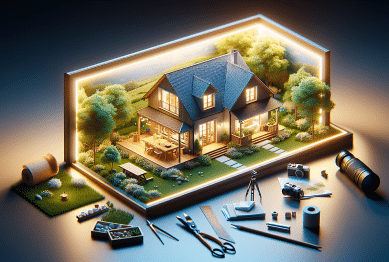Discover why the tiny home trend attracts so many people and what it truly takes to create a comfortable, sustainable dwelling in a compact space. This guide covers design tips, building materials, cost factors, and maintenance essentials for anyone curious about embracing tiny home living.
Embracing Tiny Home Living: What Draws People In
Many individuals are fascinated by the appeal of tiny home living because it represents simplicity, freedom, and creative design solutions. For some, living in a compact house offers the chance to minimize physical clutter and mental distractions. Optimizing small spaces in a tiny home pushes residents to focus only on what truly matters, inspiring a decluttered, more intentional daily life. Downsizing can mean letting go, not just of things, but also the ongoing stress of maintaining a regular-sized house. This movement is as much about personal fulfillment as it is about real estate.
Financial considerations often play a significant role in the decision to go tiny. Owning a smaller house generally leads to lower upfront costs and ongoing expenses. With less square footage, energy bills, property taxes, and insurance costs can be dramatically reduced—adding up to long-term savings. Some individuals are attracted to the idea of living mortgage-free, enabling greater flexibility and the possibility to travel or invest in other interests. By reducing financial pressure, tiny homes often provide a path toward economic security or early retirement, which motivates many to take the leap.
The environmental benefits of tiny house living can be compelling as well. Smaller spaces have a reduced ecological footprint: less energy to heat or cool, less water consumption, and fewer materials needed for both construction and upkeep. For ecologically conscious individuals, the option to incorporate solar panels, composting toilets, and rainwater collection plays a major role. Many tiny home enthusiasts share a passion for sustainability, making this lifestyle a practical way to align values with everyday choices. The chance to conserve both natural resources and money makes this lifestyle doubly rewarding (https://www.epa.gov/greenbuilding).
Essential Design Principles for Tiny Spaces
Maximizing function without sacrificing aesthetics is the heart of tiny home design. Every inch matters, so furniture often serves more than one purpose. Fold-out beds, tables that tuck away, and storage hidden beneath seating areas are staples. Good design is not about restricting options—it’s about choosing smart, flexible solutions. Natural light plays a key role in making spaces feel bigger than they are. Large windows, skylights, and glass doors blur the boundaries between indoors and outdoors. This approach helps combat any sense of confinement.
Vertical space becomes valuable real estate within a tiny home. Lofts, tall shelving, and suspended storage add square footage without expanding the house’s footprint. Built-in cabinetry and under-stair drawers help organize necessities out of sight, creating a clutter-free environment. Clever color palettes also impact perception of size. Lighter tones and mirrored surfaces reflect light and visually expand rooms, making small areas feel open and inviting. The right design choices can transform limited square footage into a vibrant, livable space that doesn’t feel cramped.
Multi-use zones are another secret behind successful tiny home interiors. One room might serve as both an office and sleeping area, or the kitchen nook could convert into a lounge. Design principles like open floor plans and minimal barriers help circulate air and brighten interiors, further enhancing comfort and usability. The result? Even a home with less than 400 square feet can provide all the essentials for daily living—sometimes with surprising comfort and style (https://www.houzz.com/magazine/how-to-make-a-tiny-home-work-houzz-stsetivw-vs~62316582).
Building Materials and Energy-Efficiency Considerations
The choice of materials significantly impacts tiny home durability and comfort. Popular options include sustainably harvested wood, composite boards, and recycled metals. Selecting high-performance insulation is essential, especially in varying climates. Properly insulated tiny homes retain warmth in winter and stay cooler in summer, reducing both energy bills and environmental impact. Many builders also look for low-VOC paints and finishes, which improve indoor air quality and create a healthier living environment. Each building material chosen should serve both form and function, especially with space at a premium.
Energy efficiency is at the core of many tiny house designs. Compact living makes it easier to heat and cool spaces quickly but also means good ventilation and moisture control are critical. Double-glazed windows, tight-sealing doors, and strategically placed vents help maintain an energy-smart environment. The integration of renewable energy systems—such as solar panels or wind turbines—turns tiny homes into showcases of sustainable technology. These upgrades can streamline utility costs, shrink the home’s carbon footprint, and even create opportunities for living off the grid.
Environmental certifications and voluntary standards like LEED or Energy Star are becoming more common in the tiny home industry. Achieving such certification boosts resale value, enhances comfort, and often opens the door to incentives like lower utility rates or rebates. Choosing eco-friendly materials and integrating advanced building technologies can be a wise investment. For those who value sustainability, every construction decision is a step toward a greener, cleaner future (https://www.energy.gov/energysaver/design/energy-efficient-home-design).
Total Cost and Financing Factors for Tiny Homes
Understanding the total cost of building or purchasing a tiny home is essential before starting the journey. Costs can range widely, influenced by factors like materials, location, design complexity, or whether one chooses a do-it-yourself project versus hiring professional builders. While the initial investment is typically lower than standard homes, there are hidden expenses: land acquisition, permits, utility hookups, and, in some cases, foundation requirements. Financing can also be more complicated, as some banks may not offer traditional mortgages for non-standard dwellings. Knowing the landscape can help buyers prepare in advance.
Insurance for tiny homes presents unique challenges. Unlike conventional homes, many tiny houses are mobile and require specialized insurance plans, mixing elements of home, auto, and even RV policies. Additionally, local regulations and zoning laws affect where tiny homes may be legally sited. Some communities have become more welcoming, offering incentives or creating dedicated tiny home villages, but zoning remains an evolving issue. Prospective owners should research local rules carefully and budget for any extra regulatory costs. Planning ahead ensures a smoother process from blueprint to move-in day.
Long-term affordability arises from reduced utility bills and maintenance needs, which often offset higher upfront expenses for quality materials or specialized labor. Some consumers are surprised by the overall value gained from downsizing living space; not only do they save on ongoing costs, but they also reallocate resources toward travel, hobbies, or investments. With careful planning, tiny homes offer a realistic pathway to budget-friendly, sustainable living. By weighing initial costs against recurring savings, potential homeowners can make informed decisions that match their priorities (https://www.fanniemae.com/research-and-insights/perspectives/tiny-homes-financing).
Maintaining and Caring for a Tiny Home
Ongoing maintenance is crucial in any home, but especially so in a tiny house where systems and surfaces are under constant use. Compact living means appliances run more frequently, and limited counter space demands daily cleaning routines. Regular inspection for moisture, pests, and air leaks help keep problems from worsening. Simple habits—like tidying as you go, scheduling routine checks, and using multi-purpose cleaning tools—can extend the life of fixtures and finishes. Preventative care is a wise habit that safeguards comfort for years to come.
Mechanical systems like plumbing, electrical, and HVAC need special attention in small dwellings. Because these systems are often condensed or combined, identifying and addressing issues early is important. Choosing energy-efficient, appropriately sized appliances matters, too; they prevent unnecessary strain while meeting daily needs. Rainwater harvesting and composting toilets also require regular upkeep but reward residents with further cost savings and environmental benefits. By understanding the care required, homeowners can enjoy peace of mind and comfort without surprises.
Mental well-being is tightly linked to an organized, tidy space. In tiny homes, regular decluttering, rearranging, and deep cleaning become part of the lifestyle. Multifunctional furniture keeps things flexible, while rotating items seasonally ensures that nothing overstays its welcome. Some owners embrace digital minimalism as well, reducing digital clutter alongside physical possessions. The upshot: minimal upkeep, maximum comfort—an approach that keeps stress low and satisfaction high (https://www.habitat.org/stories/simple-living-and-maintenance-tips-tiny-homes).
Sustainability Benefits and Community Impact
One of the most rewarding aspects of tiny home ownership is contributing to environmental conservation. These compact houses consume fewer resources, generate less waste, and encourage more mindful consumption habits. By adopting renewable energy, water-saving fixtures, and sustainable building methods, tiny house dwellers often set positive examples in their communities. Living small can be a statement in favor of a greener, more considerate world, inspiring neighbors to rethink resource use and household management.
Many communities are recognizing the potential of tiny homes to address broader social challenges. From offering affordable housing solutions in high-rent cities to supporting veterans or those experiencing homelessness, tiny house developments have become part of diverse urban planning strategies. City planners experiment with zoning laws, creating opportunities for tiny home villages, ADU developments, and flexible, multi-generational living. The expanding reach of this movement demonstrates its viability, not just as a personal choice, but as a scalable housing model for modern society.
For many, tiny living also means greater connection with like-minded people. Residents often share resources, swap tips, and participate in community gardens or collective maintenance efforts. Cohesive tiny home communities offer a sense of belonging and support that larger, more dispersed neighborhoods sometimes lack. The social benefits, coupled with environmental sustainability, position tiny homes as a thoughtful answer to contemporary housing challenges (https://www.urban.org/urban-wire/can-tiny-homes-help-meet-affordable-housing-needs).
References
1. U.S. Environmental Protection Agency. (n.d.). Green Building. Retrieved from https://www.epa.gov/greenbuilding
2. Houzz. (n.d.). How to Make a Tiny Home Work. Retrieved from https://www.houzz.com/magazine/how-to-make-a-tiny-home-work-houzz-stsetivw-vs~62316582
3. U.S. Department of Energy. (n.d.). Energy Efficient Home Design. Retrieved from https://www.energy.gov/energysaver/design/energy-efficient-home-design
4. Fannie Mae. (n.d.). Tiny Homes Financing and Perspectives. Retrieved from https://www.fanniemae.com/research-and-insights/perspectives/tiny-homes-financing
5. Habitat for Humanity. (n.d.). Simple Living and Maintenance Tips for Tiny Homes. Retrieved from https://www.habitat.org/stories/simple-living-and-maintenance-tips-tiny-homes
6. Urban Institute. (n.d.). Can Tiny Homes Help Meet Affordable Housing Needs? Retrieved from https://www.urban.org/urban-wire/can-tiny-homes-help-meet-affordable-housing-needs









